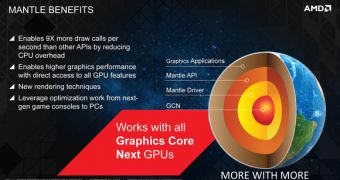Back in September, Advanced Micro Devices released the Mantle when it introduced the Radeon RX series of graphics cards, the so-called Hawaii line. Now, some more details have emerged about the API.
Mantle, in a nutshell, is an application programming interface that can be used instead of OpenGL and even DirectX.
In fact, AMD says that Mantle should be used instead of those two, at least on systems featuring a graphics card powered by the GCN architecture (graphics core next).
Mantle bypasses all the bottlenecks in modern PC/API architectures and allows for nine times more draw calls per second than the two alternatives we mentioned. Lower CPU overhead allows for this.
In layman terms, Mantle will make your games run several times more smoothly on Radeon graphics cards, assuming the game was designed for it.
Right now, only Battlefield 4, a shooter expected to come out in December, is on that list. AMD actually worked with EA/DICE on the Mantle, and BF4 will be a proving ground of sorts.
That said, Mantle will stay proprietary for now, but AMD will eventually open it to everyone else, turning it into a real contender to DirectX 11 and whatever comes after.
“I think at this stage it makes sense for us to develop Mantle, at least in its current form, because nobody knows our hardware at the lowest level best than we do. So for us to have to do that for alternative graphics hardware [would be] almost impossible,” said Ritche Corpus, AMD’s director of software alliances and developer relations, in an interview with VR-Zone.
In addition to enhancing performance, Mantle should eventually be able to introduce new visual effects in games, much like 3dfx did back in the 20th century.
“The long term plan is to share and create the spec and SDK and make it widely available. Our thinking is: there’s nothing that says that someone else could develop their own version of Mantle and mirror what we’ve done in how to access the lower levels of their own silicon. I think what it does is it forges the way, the easiest way,” said Mr. Corpus.

 14 DAY TRIAL //
14 DAY TRIAL //